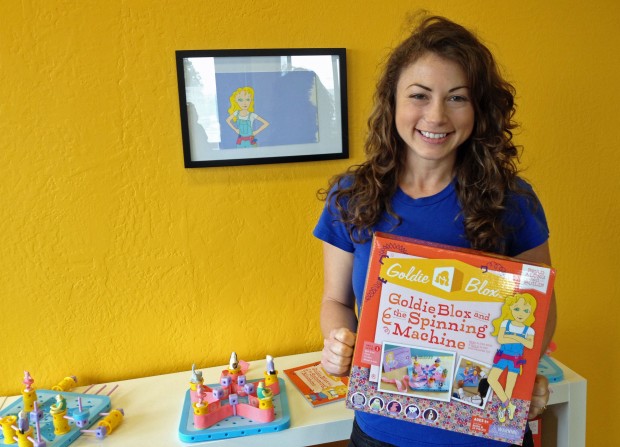Research shows that building toys like Legos or Erector Sets are good for building spatial skills, but those typically fall under the stereotype of toys for boys. After visiting the toy store and experiencing what she called “the pink explosion isle for girls” Sterling decided she needed to build an engineering toy that would appeal to girls.
GoldieBlox and the Spinning Machine is a construction kit with pieces that clip into a board to make a simple belt drive. The set comes with a story that tells of a girl engineer named Goldie who wants to build a spinning machine so all her friends can spin together. She takes apart a jewelry box to learn about the spinning mechanism and then builds her own.
[RELATED READING: Giving Good Praise to Girls: What Messages Stick?]
“My 'ah ha' moment was that instead of a construction toy only, which is spatial skills and object play, I would combine spatial skills with verbal, so I would have the construction toy plus the book,” Sterling said. “By introducing the story of Goldie and these characters, and building for a reason, it gave girls the context they were craving and the narrative behind the play that was meaningful to them.”
She came up with the idea of her hybrid story-building toy by observing that girls prefer narrative-based play. She hoped she could draw girls in with a story and after directing them to follow along with Goldie as she builds, they’d get comfortable tinkering with the construction kit. Once they're comfortable with the parts and how they work, the hope is that they begin to design their own machines.
“Some modeling of a cool, young girl engineer could be useful if the girl playing can see a path from where she is to where the cool, functioning engineer is,” said Carol Dweck, a professor of psychology at Stanford University. She said the connection between the toy and engineering needs to be clear and that the hands on-skills girls learn at young ages need to be continual reinforcement for the effects to last.
Goldie can be a role model to younger girls, while the inventor herself can model what a successful female engineer looks like to older girls. “She’s not the kid genius,” Sterling said describing Goldie. “She’s well liked; she’s fun; she’s quirky; she’s a little messy. I guess that is a bit like me.”
Sterling said in its early days the toy has been very popular with engineering parents. “It touched my heart that it was a mechanical toy that was targeted towards young girls,” said Martin Miller, an engineer who pre-ordered GoldieBlox for his six-year-old daughter Kaitlin when the toy appeared on Kickstarter. “That’s unusual and I felt that was perfect for my little daughter.” Kaitlin has two older brothers and Miller considers a tomboy, so he thought she’d like a building toy. She has also already begun to play with the characters off the board, imagining scenes for Goldie and her friends.
Sterling hoped her toy would inspire creative play and was also aware of research like Carol Dweck’s that shows kids need to learn to struggle with difficult concepts so they know how to tackle setbacks in the future.
“From a very young age I would start stressing the fun and interestingness of difficult tasks,” Dweck said. “When something is easy I’d say, ‘oh that’s boring, that’s a waste of time.’”
[RELATED READING: How to Foster Grit, Tenacity and Perseverance: An Educator's Guide]
In the first draft of the story, Sterling had Goldie build a machine that didn’t work. But when Sterling tested the story line, girls and their parents got so frustrated that the machine didn’t work that they refused to turn the page and continue. So Sterling softened the failure.
“I have a moment where Goldie is perplexed,” she said. “So I don’t set anyone up for failure, but I show that she’s confused and she doesn’t know the answers and she goes through a series of funny moments where she tries a bunch of things until she finally works it out.”
That strategy is in line with Dweck’s research on how to keep kids striving for challenging tasks. “If you have little failures along the way and have them understand that’s part of learning, part of building and that you can actually derive useful information about what to do next -- that’s really useful,” Dweck said.
Some specialty toy stores are already stocking GoldieBlox after the Kickstarter campaign Sterling launched to fund manufacturing went viral and more than doubled its goal. “From the very beginning I knew I wanted this girl character sitting on the shelf next to Bob the Builder and Thomas the Train,” Sterling said.
The game costs $29.99 and the three additional story lines and accompanying kits that Sterling is working on will likely have similar price tags.


